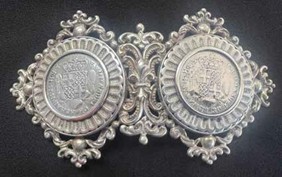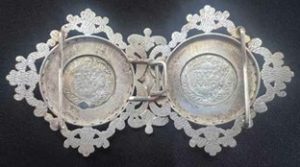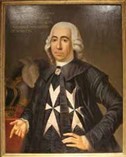A deeper legacy. The women who wore the buckles
Among the artifacts displayed at the St John National Museum is a pair of silver nurse’s belt buckles, which stand as powerful symbols of the critical role women played during World War 1. These beautifully crafted accessories, featuring Maltese coins from 1780, not only showcase exquisite craftsmanship but also illuminate the important contributions of women in wartime healthcare and service.


The buckles, which likely date back to the period of World War I, were created in Malta, where such accessories were commonly worn by nurses. The intricate filigree design, with a small fleur-de-lis at the centre, reflects both the style of the time and the practical needs of women working under extreme conditions to care for soldiers. These women, members of the St John Ambulance Brigade, were on the front lines, providing essential medical care to the wounded, perhaps under fire or in dangerous conditions.
The coins embedded in the buckles are engraved with the name ‘F. Emmanuel de Rohan M.M.H.S.S.’, a reference to Fra Emmanuel de Rohan-Polduc, the second-last Grand Master of the Sovereign Military Order of Malta. The Order was known for its long history of providing medical care, especially during wartime. The inclusion of these coins ties the buckles to the legacy of service upheld by the Order of Malta and reflects the values of mercy and care that guided the women who wore them.
These buckles were donated to the St John Museum in 2004 by Charles A Campbell GCStJ, who purchased the items in Moss Vale around 2000. Unbeknownst to him at the time, these buckles would come to symbolise the quiet courage and selfless service of the women who wore them during one of history’s most devastating conflicts.
A deeper legacy. The women who wore the buckles
The women who wore these buckles were more than just caregivers—they were a part of a vital network of medical workers that sustained soldiers during World War I. The St John Ambulance Brigade, where many women served, was a key player in wartime healthcare, with women taking on essential roles as nurses, caregivers, and educators. These women worked tirelessly under harsh conditions in field hospitals, offering care to the wounded, sometimes under fire, and providing emotional support to soldiers in desperate need.
The story of these buckles also highlights the larger legacy of women in the St John Ambulance Brigade, an organisation traditionally led by men, but where women played an indispensable role. By the early 20th century, many women had become leaders within the organisation, training others in first aid and assuming key responsibilities in the delivery of emergency care. During both World Wars, these women were instrumental in providing medical care, not just for soldiers but for civilians caught in the conflict as well.
Their work extended far beyond medical treatment. The women of St John played an essential role in maintaining morale among soldiers, offering comfort, support, and compassion during times of immense suffering. They were often among the first to arrive at disaster sites, prepared to offer care, and remained long after the immediate danger had passed.
The Role of Fra Emmanuel de Rohan-Polduc. A symbol of leadership and tradition
The Maltese coins embedded in the buckles carry more than just a historical connection— they serve as symbols of the enduring tradition of service that the women who wore the buckles upheld. These coins feature the name of Fra Emmanuel de Rohan-Polduc, the 70th Grand Master of the Sovereign Military Order of Malta, a key figure in the Order’s long-standing commitment to humanitarian service. Fra Emmanuel led the Order during the late 18th century, and under his leadership, the Order expanded its reach in providing medical care, including during wartime.
The Sovereign Military Order of Malta, with its centuries-old focus on charity and care for the sick, has long been associated with providing medical aid, particularly in times of war. The inclusion of Fra Emmanuel’s name on the coins embedded in these buckles ties the women who wore them to this larger humanitarian mission. The buckles, in this sense, are not just symbols of individual service but part of a broader, global legacy of mercy, relief, and protection of the vulnerable.
By feat uring Fra Emmanuel’s name, the coins underscore the historical connection between Malta, the Order of Malta, and the medical services provided during wartime. His leadership ensured that the Order’s core values—care for the sick, compassion, and mercy—were central to its mission, and these values were embodied by the women who wore these buckles in the trenches of World War I.
uring Fra Emmanuel’s name, the coins underscore the historical connection between Malta, the Order of Malta, and the medical services provided during wartime. His leadership ensured that the Order’s core values—care for the sick, compassion, and mercy—were central to its mission, and these values were embodied by the women who wore these buckles in the trenches of World War I.
Honouring the legacy. Women in wartime healthcare
The legacy of the women who wore these buckles is often overshadowed by the larger narrative of soldiers on the battlefield, yet their contributions were vital to the survival and well-being of those around them. These nurses and caregivers not only treated the physical wounds of soldiers but also offered comfort, often in life-or-death situations, and provided emotional support to those facing unimaginable trauma. Their tireless work, performed in extremely difficult conditions, is a testament to their dedication and selflessness.
These silver buckles stand as a tribute to the courage of the women who wore them, offering a tangible connection to the past and reminding us of the significant, though often unrecognised, role women played in the history of war-time healthcare. Through these buckles, we see the broader story of St John Ambulance, the Sovereign Military Order of Malta, and the ongoing legacy of women’s service in healthcare.
Today, the women of St John continue to embody the same values of care, compassion, and service. Their contributions to healthcare—whether in disaster response, emergency services, or medical training—remain as vital as ever. The legacy of the women who wore these buckles continues to inspire future generations, ensuring that the spirit of mercy and service endures. Remembering the unsung heroes
As we reflect on these buckles today, we are reminded of the quiet but essential contributions made by women during times of war. These women were unsung heroes—often overlooked by history—but their service was indispensable to the success of wartime medical efforts. The silver belt buckles, now part of the St John Museum collection, stand as a lasting tribute to their bravery, their sacrifices, and their unwavering dedication to serving others.
The story of these buckles is not just one of historical interest, but a reminder of the vital role that women have played, and continue to play, in healthcare, service, and humanitarian aid. Through the donation of these buckles, Charles A. Campbell has helped ensure that the legacy of the women who wore them will never be forgotten. These buckles are more than artifacts; they are enduring symbols of courage, compassion, and the quiet strength of women who, in times of crisis, stepped forward to heal, comfort, and serve.
Teryn Edwards
Immediate-Past Priory Administrator
Published 12 August 2025, in part in Pro Utilitate 2025 Issue 2
